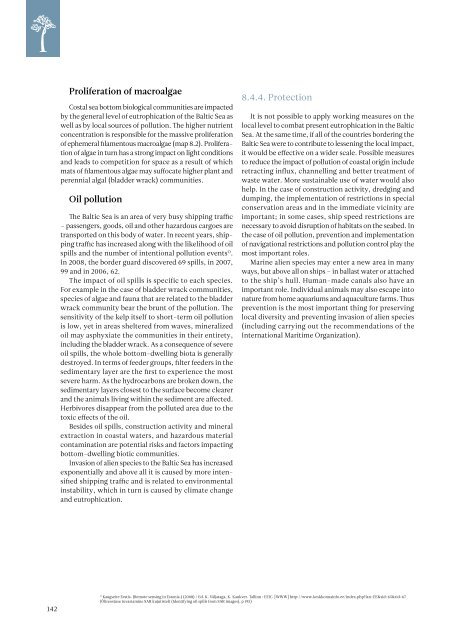ESTONIAN ENVIRONMENTAL REVIEW 2009
ESTONIAN ENVIRONMENTAL REVIEW 2009
ESTONIAN ENVIRONMENTAL REVIEW 2009
You also want an ePaper? Increase the reach of your titles
YUMPU automatically turns print PDFs into web optimized ePapers that Google loves.
Proliferation of macroalgae<br />
Costal sea bottom biological communities are impacted<br />
by the general level of eutrophication of the Baltic Sea as<br />
well as by local sources of pollution. The higher nutrient<br />
concentration is responsible for the massive proliferation<br />
of ephemeral filamentous macroalgae (map 8.2). Proliferation<br />
of algae in turn has a strong impact on light conditions<br />
and leads to competition for space as a result of which<br />
mats of filamentous algae may suffocate higher plant and<br />
perennial algal (bladder wrack) communities.<br />
Oil pollution<br />
The Baltic Sea is an area of very busy shipping traffic<br />
– passengers, goods, oil and other hazardous cargoes are<br />
transported on this body of water. In recent years, shipping<br />
traffic has increased along with the likelihood of oil<br />
spills and the number of intentional pollution events O .<br />
In 2008, the border guard discovered 69 spills, in 2007,<br />
99 and in 2006, 62.<br />
The impact of oil spills is specific to each species.<br />
For example in the case of bladder wrack communities,<br />
species of algae and fauna that are related to the bladder<br />
wrack community bear the brunt of the pollution. The<br />
sensitivity of the kelp itself to short-term oil pollution<br />
is low, yet in areas sheltered from waves, mineralized<br />
oil may asphyxiate the communities in their entirety,<br />
including the bladder wrack. As a consequence of severe<br />
oil spills, the whole bottom-dwelling biota is generally<br />
destroyed. In terms of feeder groups, filter feeders in the<br />
sedimentary layer are the first to experience the most<br />
severe harm. As the hydrocarbons are broken down, the<br />
sedimentary layers closest to the surface become clearer<br />
and the animals living within the sediment are affected.<br />
Herbivores disappear from the polluted area due to the<br />
toxic effects of the oil.<br />
Besides oil spills, construction activity and mineral<br />
extraction in coastal waters, and hazardous material<br />
contamination are potential risks and factors impacting<br />
bottom-dwelling biotic communities.<br />
Invasion of alien species to the Baltic Sea has increased<br />
exponentially and above all it is caused by more intensified<br />
shipping traffic and is related to environmental<br />
instability, which in turn is caused by climate change<br />
and eutrophication.<br />
8.4.4. Protection<br />
It is not possible to apply working measures on the<br />
local level to combat present eutrophication in the Baltic<br />
Sea. At the same time, if all of the countries bordering the<br />
Baltic Sea were to contribute to lessening the local impact,<br />
it would be effective on a wider scale. Possible measures<br />
to reduce the impact of pollution of coastal origin include<br />
retracting influx, channelling and better treatment of<br />
waste water. More sustainable use of water would also<br />
help. In the case of construction activity, dredging and<br />
dumping, the implementation of restrictions in special<br />
conservation areas and in the immediate vicinity are<br />
important; in some cases, ship speed restrictions are<br />
necessary to avoid disruption of habitats on the seabed. In<br />
the case of oil pollution, prevention and implementation<br />
of navigational restrictions and pollution control play the<br />
most important roles.<br />
Marine alien species may enter a new area in many<br />
ways, but above all on ships – in ballast water or attached<br />
to the ship’s hull. Human-made canals also have an<br />
important role. Individual animals may also escape into<br />
nature from home aquariums and aquaculture farms. Thus<br />
prevention is the most important thing for preserving<br />
local diversity and preventing invasion of alien species<br />
(including carrying out the recommendations of the<br />
International Maritime Organization).<br />
142<br />
O<br />
Kaugseire Eestis. (Remote sensing in Estonia.) (2008) / Ed. K. Väljataga, K. Kaukver. Tallinn : EEIC. [WWW] http://www.keskkonnainfo.ee/index.php?lan=EE&sid=65&tid=67<br />
(Õlireostuse tuvastamine SAR kujutistelt (Identifying oil spills from SAR images), p 195)

















